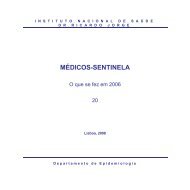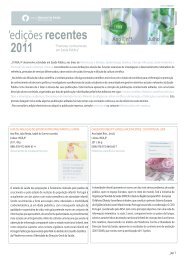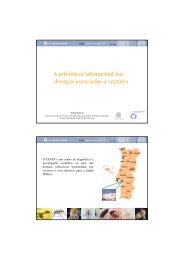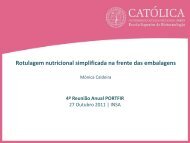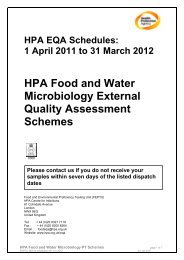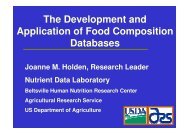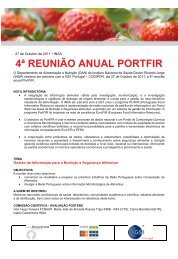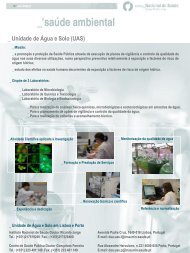European Society of Mycobacteriology - Instituto Nacional de Saúde ...
European Society of Mycobacteriology - Instituto Nacional de Saúde ...
European Society of Mycobacteriology - Instituto Nacional de Saúde ...
You also want an ePaper? Increase the reach of your titles
YUMPU automatically turns print PDFs into web optimized ePapers that Google loves.
PP-32<br />
DOES A MUTATION IN THE RPOB MEAN THAT THE<br />
M.tuberculosis IS RESISTANT TO RIFAMPICIN?<br />
Yates, Malcolm; Brown, Tim; Drobniewski, Francis<br />
HPA National Mycobacterium Reference Unit<br />
Testing for mutations in the “hot spot” region <strong>of</strong> the rpoB gene is gaining momentum for the diagnosis <strong>of</strong> rifampicin<br />
resistant strains <strong>of</strong> M.tuberculosis and as a surrogate marker for MDRTB.<br />
The use <strong>of</strong> PCR combined with hybridisation to commercial strips (Hain Lifesciences, Innolipa)has <strong>de</strong>creased time and<br />
increased ease <strong>of</strong> use so that these investigations are being performed by more and more laboratories.<br />
The strips consist <strong>of</strong> a series <strong>of</strong> overlapping probes that cover the whole region (S bands) and are all present in Wild Type<br />
isolates. There are also a series <strong>of</strong> probes (R bands) covering the commonest mutations which are linked with rifampicin<br />
resistance and with the <strong>de</strong>letion <strong>of</strong> the corresponding S band.<br />
Occasionally an S band is <strong>de</strong>leted with no R band appearing. We report these as “uni<strong>de</strong>ntified mutations”. The question<br />
is whether these isolates are resistant or sensitive to rifampicin.<br />
Recently we i<strong>de</strong>ntified three patients from Sao Tome, an island <strong>of</strong>f the West Coast <strong>of</strong> Africa (population 55000),<br />
with a strains <strong>of</strong> M.tuberculosis that had the same S band <strong>de</strong>leted. Sequencing data showed that the strains had the<br />
same synonymous mutation, VNTR/MIRU pr<strong>of</strong>iles were i<strong>de</strong>ntical, and all strains were fully sensitive to first line drugs.<br />
On analysis <strong>of</strong> our database, 466 strains were found to have rpoB mutations, 103 (22%) <strong>of</strong> these were uni<strong>de</strong>ntified mutations<br />
<strong>of</strong> which 13% were sensitive to rifampicin. A further 15 isolates gave a WT result but were rifampicin resistant.<br />
All strains were sequenced to i<strong>de</strong>ntify the mutation.<br />
Before rpoB mutations can be used as a surrogate for MDRTB the rate <strong>of</strong> mono-resistance to rifampicin in the area must<br />
be <strong>de</strong>termined: e.g. in the London area 30% <strong>of</strong> rifampicin resistance is mono.<br />
Care must, therefore, be taken when reporting these rpoB mutation results to Clinicians as<br />
1) uni<strong>de</strong>ntified mutations do not always correspond to rifampicin resistance and 2) rpoB mutations may not always correspond<br />
to MDRTB<br />
104 ESM 2009



